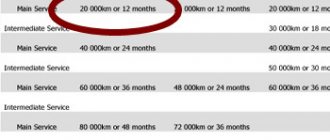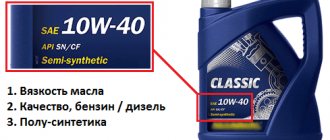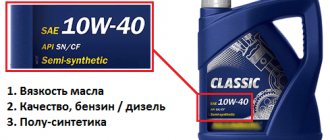Toyota Land Cruiser Prado cars are not only in great demand, but also greatly respected. This is a large SUV with good technical characteristics, reliable power units, a comfortable interior and impressive durability. That’s why even samples from the 90s are still in demand, are in excellent condition and can compete with many modern cars.
Operating conditions affect the frequency of engine oil changes in Toyota Land Cruiser Prado.
When is a Toyota Land Cruiser Prado oil change required?
The frequency of replacement depends on the operating conditions of the machine. This has a significant impact.
The manufacturer indicates in the instructions for using the vehicle a certain average - about 15 thousand kilometers. However, climatic and other factors differ in different regions. For example, in Russia it is recommended to change engine oil at intervals of six to seven thousand kilometers. One of the reasons is the need to warm up the Toyota engine in winter. It is important to change technical fluids on time to ensure reliable protection of the unit.
As for automatic transmissions, it is better to change transmission fluids every sixty thousand kilometers traveled. With quiet driving, mainly on highways, this interval can be increased to one hundred thousand kilometers. Fresh oil significantly improves transmission performance and increases vehicle life.
For new cars under warranty, the oil change is performed as part of scheduled maintenance.
Although the manual for using the Prado 150 recommends changing diesel engine oil every 10,000 km, in reality, car enthusiasts do this earlier - approximately every 8,500 km. This is due to the quality of the road surface, gasoline (diesel) and the selected lubricant.
Weather conditions also have an impact. So, in regions with low average annual temperatures, you have to warm up your Toyota before driving.
The following factors may be signs that it is time for an oil change:
- unclear gear shifting;
- deterioration of traction and lack of speed;
- increased fuel consumption;
- unnecessary sounds and vibration while driving.
The fact that it is time to change the oil is indicated by its structure, smell, and color. Unsuitable lubricant has a black-brown tint, contains foreign inclusions (chips, soot), and smells burnt.
Timely replacement of technical fluids ensures reliable engine protection.
Sometimes a replacement is made at the request of the car owner, if for some reason he is not satisfied with the type of oil or the manufacturer.
Consequences of untimely replacement
Possible car breakdowns due to untimely replacement of engine oil:
- Turbocharger rupture.
- Visible damage to the internal combustion engine system.
- A mixture of fuel and engine oil, which can lead to general vehicle breakdown.
- Breakdown of the SUV gearbox.
- Car sagging.
- Reducing the overall power of the vehicle.
- Oil filter rupture.
This is interesting: How to make a simple device for checking spark plugs
Repairing a car is an expensive process.
Regularly updating the lubricating consumables in a car can prevent it, as well as reduce a significant amount of damage in the vehicle’s internal combustion engine system.
Power steering (power steering)
Power steering helps you turn the steering wheel along with the wheels, while you spend several times less force than a car without a power steering system.
There are marks on the power steering expansion tank by which you can understand whether the fluid level is currently high or, conversely, low and needs to be added. A quick inspection of the power steering system can solve many problems along the way, so look under the hood once a month.
What should you pay attention to?
- Monitoring the power steering fluid (oil) level and its color in the expansion tank;
- Checking the drive belt for the power steering pump;
- General condition of hoses (inspection for cracks, abrasions and chips);
- Hose connection points.
How to change
Changing the power steering fluid (oil) can be done in several ways, including partially changing the fluid and completely changing it. The first method is faster and easier, the second is better.
Partial replacement
Partial replacement of power steering fluid involves pumping fluid out of the power steering expansion tank using a large syringe or bulb. After the tank is completely empty, fill in fresh fluid to the maximum mark. Start the car and turn the steering wheel left/right. After a few minutes, turn off the engine and check the color of the power steering fluid. If it is too dark, repeat the procedure until the desired result.
Complete replacement
To replace the power steering fluid, remove the air duct and the reservoir with power steering fluid. Pour the old liquid from the barrel into another container. When draining, pay attention to the condition of the old oil and the presence of foreign metal particles. If they are noticeable, this may indicate wear on the pump. To completely drain the power steering, you can rotate the steering wheel left and right.
Necessary tools and materials for oil change
To work you will need to prepare:
- 24 mm wrench;
- filter puller;
- containers of suitable volume for processing;
- gloves/protective equipment;
- rags;
- replacement consumables.
If desired, you can further clean the engine from waste using flushing agents (special liquid or additives).
The manufacturer does not recommend their use, as it harms the diesel engine.
Which oil should you choose?
The choice of oil is a responsible process, since not only the duration of operation of the lubricant itself and the engine as a whole, but also the quality of operation of the vehicle’s power unit depends on its quality and compatibility. First of all, you should focus on the following characteristics:
- Composition: mineral or synthetic.
- Viscosity.
- Originality of the manufacturer.
The oil forms a film on the internal parts of the engine, protecting against premature wear and overheating. This is only possible if you use a proven product that matches the engine parameters.
We must not forget about the viscosity of the lubricant. It is selected based on the climate zones in which the machine is used.
The diesel Toyota Land Cruiser Prado 150 is equipped with a more durable engine than previous models. Official dealers advise choosing a lubricant with a viscosity of 0w-30, 5W-30, 5W-40 and ACEA C2 quality class. The original TLC oil is Toyota Genuine Motor Oil, but fluids with equivalent parameters are also used, such as Idemitsu Zepro diesel DL-1 5W-30, Top Tec 4200 5W-30, NGN Nord 5W-30 and others.
When changing the oil in a 3.0-liter 1KD-FTV engine, the best choice would be SAE 5W-30, because it ensures quick starting of the Prado 150 diesel engine in the cold season.
The machine loses warranty service if a lubricant not recommended by the manufacturer is used.
Generation history and engine range
There are 4 generations in the Toyota Prado line. The first generation (J70) started selling in 1990. Toyota Land Cruiser Prado was a lighter version of the Land Cruiser 70. Those cars were equipped with 2.4 and 2.7 liter naturally aspirated injection engines. Diesel versions had a volume of 2.8 liters. There were also turbodiesel engines of 2.3 and 3.0 liters. The first generation was produced for six whole years until 1996.
The second generation (J120) was also produced for six years (from 1996 to 2002). The second generation Toyota Land Cruiser Prado was also equipped with an old 2.7 liter engine and a new 3.4 liter (with V6). In 1999, the appearance was restyled, but in 2000 a new 3.0 turbocharged diesel engine was added.
The third generation (J120) was produced from 2002 to 2009. The engines were the same 2.7 and 3.4 petrol, 3.0 liter turbodiesel. In 2004, there was a big upgrade of engines, where the old ones were replaced by new ones of 2.7 liters and 3.0 liters. The turbodiesel was also replaced with a 4.0 liter.
The fourth generation (J150) began production in 2009. It was made on the updated 120 series platform. In appearance it was more like a previous generation car.
The process of changing the oil in a Toyota Prado engine with your own hands
To change the oil, no special skills are required. The car owner can do everything with his own hands, without using the services of car services. To do this you need to do the following:
- Drive the vehicle into the pit. If it is not there, then use a jack. Warm up the engine for 5-8 minutes. Next, it is better to carry out all manipulations with gloves so as not to injure the skin with hot liquid.
- Remove the engine crankcase protection. Prepare a container for the waste liquid. Carefully unscrew the drain plug. It is recommended to leave the car in this position for an hour - this will ensure maximum cleansing of the engine from oil residues.
- While the waste is draining, you can replace the oil filter: unscrew the used one using a special puller. You need to pour a little oil into the new part, lubricate the rubber seal, remove dirt on the seat with a rag, and install a filter.
- When the waste has drained, you can further clean the engine with flushing fluid or special additives. This will remove any settled debris.
- Now you can fill in new oil and check its quantity with a dipstick. The level decreases after the first start due to the fact that the lubricant is distributed throughout the system.
- Close the drain with a plug. A poorly tightened drain plug may leak in the future.
- Start the car. Leave the engine running at idle speed for 12-15 minutes.
- Take final volume measurements.
This is interesting: Do-it-yourself VAZ 2112 car repairs - 16 valves
Despite the impressive dimensions of the Toyota Land Cruiser Prado 150, changing engine oil is no more difficult than in other cars, and timely maintenance will extend the life of the diesel engine.
Changing the oil in the Toyota Prado 150 and 120 engine
The choice of oil for diesel Prado 150 and the process of replacing the lubricant in the engine must be carried out in accordance with technical regulations. Independent renewal of motor lubrication is a responsible process, and you should give preference to the following types of oils:
- Toyota Prado 120 gasoline engine - Mobil 1 ESP Formula 5W-30 engine oil;
- Diesel engine - 1VD-FTV.
According to the recommendations of the Land Cruiser diesel manufacturer, it is necessary to thoroughly clean the system of any remaining lubricant. This will prevent unwanted damage in the future.
Partial replacement
The lubricant is constantly under pressure and heats up during engine operation, so it gradually thickens. Its color darkens, its protective functions deteriorate. The car owner should always pay special attention to the running of the engine and periodically carry out diagnostics.
Car filters are not able to completely clean the air of dirt and impurities that enter the system along with the fuel. Partially changing the engine oil will prevent possible problems.
Reasons why partial replacement is performed:
- frequent idling in long traffic jams;
- excessive loads on the engine (towing);
- driving on country roads;
- long periods of downtime;
- old age of the car.
A partial replacement is similar to a regular one, only it does not require complete pumping out of the waste - new fluid is added to the old one. Accordingly, the replacement interval will be reduced by half the established mileage.
This method has some advantages: it saves money, requires less consumables, and reduces the likelihood of parts breaking.
The oil filter is replaced when the lubricant is partially renewed as necessary.
Be sure to use the same type of lubricant. In this case, the formation of insoluble sediments in the engine is eliminated, which eliminates the need for flushing next time.
How much oil to fill
EngineCapacity
| without a filter | with filter | |
| 2.7 2TR | 5.5 | 5.9 |
| 4.0 1GR | 5.7 | 6.2 |
| 2.8 1GD | 7.2 | 7.7 |
| 3.0 1KD | 6.7 | 7.0 |
This is interesting: Repair of the driver's door lock of Nissan Tiida and Qashqai - restoration of the cable
The amount of oil is a reference amount that must be adhered to when changing the engine oil. After replacement, warm up and turn off the engine, after 5-10 minutes check the level using a dipstick.
In fact, less is filled, for example, according to the catalog in the 2TR 2.7 engine - 5.9 liters with a filter, and when changing the oil, the upper level of the dipstick holds 5 liters.
Objectives of motor oils
But in order for the machine to serve for a long time and efficiently, it requires appropriate care. One of the main conditions for maintaining engine performance is the timely replacement of engine and transmission oils and other consumables. Not every car owner knows what oils to pour into a Toyota Prado 150 with a diesel engine, which is why problems often arise and require contacting a car service center. Maintaining such a car is not cheap, so every visit to a service station costs the owner a large sum. Timely replacement and competent selection of engine oil for a Toyota Prado allows you to:
Choose among these manufacturers, based on the recommended characteristics of motor lubricants for your Prado.











